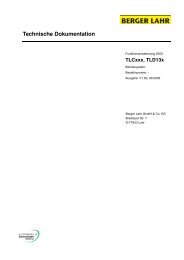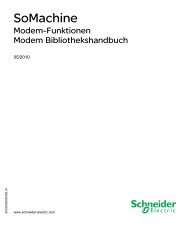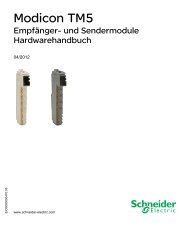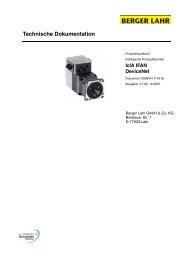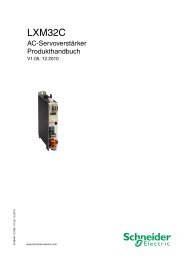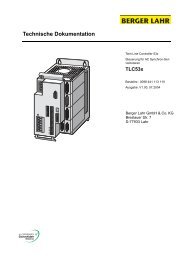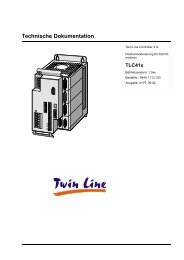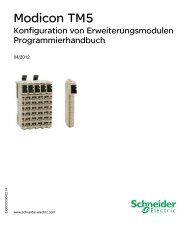Library manual M238 system functions | 2 MB - BERGER - POSITEC
Library manual M238 system functions | 2 MB - BERGER - POSITEC
Library manual M238 system functions | 2 MB - BERGER - POSITEC
You also want an ePaper? Increase the reach of your titles
YUMPU automatically turns print PDFs into web optimized ePapers that Google loves.
How to Use a Function or a Function Block in ST Language<br />
Function and Function Block Representation<br />
General Information<br />
This part explains how to implement a Function and a Function Block in ST<br />
language.<br />
Function SetRTCDrift and Function Block TON are used as examples to show<br />
implementations.<br />
Using a Function in ST Language<br />
The following procedure describes how to insert a function in ST language:<br />
Step Action<br />
1 Open or create a new POU in Structured Text language.<br />
NOTE: The procedure to create a POU is not detailed here. For more information,<br />
refer to the SoMachine global help.<br />
2 Create the variables that the function requires.<br />
3 Use the general syntax in the POU ST Editor for the ST language of a function. The<br />
general syntax is:<br />
FunctionResult:= FunctionName(VarInput1, VarInput2,..<br />
VarInputx);<br />
To illustrate the procedure, consider the function SetRTCDrift graphically<br />
presented below:<br />
Function Graphical Representation<br />
SetRTCDrift<br />
The ST language of this function is the following:<br />
Function Representation in SoMachine POU ST Editor<br />
SetRTCDrift PROGRAM MyProgram_ST<br />
VAR myDrift: SINT(-29..29) := 5;<br />
myDay: DAY_OF_WEEK := SUNDAY;<br />
myHour: HOUR := 12;<br />
myMinute: MINUTE;<br />
myRTCAdjust: RTCDRIFT_ERROR;<br />
END_VAR<br />
myRTCAdjust:= SetRTCDrift(myDrift, myDay, myHour, myMinute);<br />
EIO0000000364 04/2012 77



